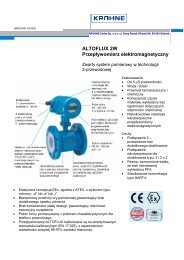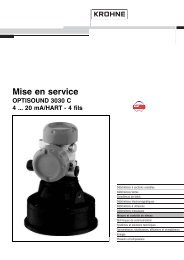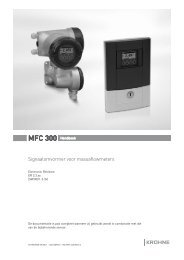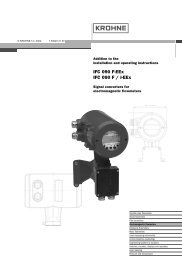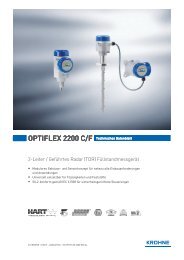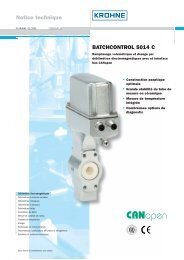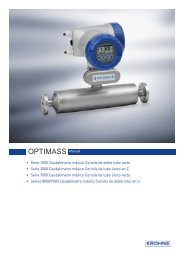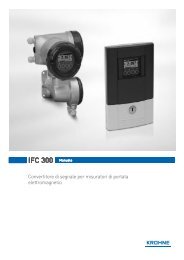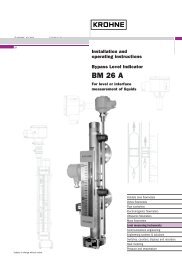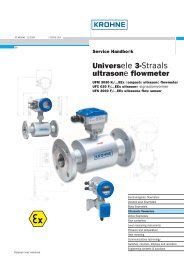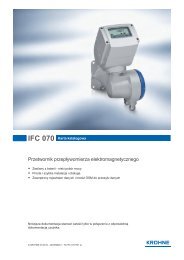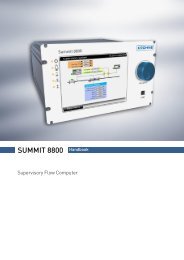ALTOSONIC V12 Modbus manual Protocol description & set-up
ALTOSONIC V12 Modbus manual Protocol description & set-up
ALTOSONIC V12 Modbus manual Protocol description & set-up
Create successful ePaper yourself
Turn your PDF publications into a flip-book with our unique Google optimized e-Paper software.
<strong>ALTOSONIC</strong> <strong>V12</strong><br />
<strong>Modbus</strong> <strong>manual</strong><br />
KROHNE CT Products<br />
<strong>Protocol</strong> <strong>description</strong><br />
&<br />
<strong>set</strong>-<strong>up</strong><br />
Liability, disclaimer<br />
KROHNE takes great care to make sure the information in this document is correct, accurate and as<br />
complete as deemed necessary. Despite this, KROHNE rejects any responsibility for the consequences of<br />
missing or incorrect information in this <strong>manual</strong>.<br />
Responsibility for <strong>set</strong>ting <strong>up</strong> and operating a <strong>Modbus</strong> communication link, as described in this <strong>manual</strong>, rests<br />
solely with parties involved in the implementation and operation of such a data communication link.<br />
It is KROHNE policy to maintain and <strong>up</strong>date this document as necessary, however this is not a controlled<br />
document. Owners of this document can not claim that KROHNE is responsible for replacing this version of<br />
this document in case an <strong>up</strong>dated version becomes available.<br />
Nothing from this document may be copied or reproduced without the written permission of<br />
KROHNE Altometer<br />
2011-07-19 <strong>ALTOSONIC</strong>_<strong>V12</strong>_<strong>Modbus</strong>_6.doc 1/28
TABLE OF CONTENTS<br />
1 INTRODUCTION......................................................................................................................................3<br />
2 PHYSICAL COMMUNICATION LAYER...................................................................................................4<br />
3 SERIAL TRANSMISSION FORMAT........................................................................................................5<br />
3.1 ASCII mode....................................................................................................................................5<br />
3.2 RTU mode......................................................................................................................................5<br />
4 MODBUS MESSAGE FRAMING .............................................................................................................6<br />
4.1 The Address Field (Device Address) .............................................................................................6<br />
4.2 The Function Field .........................................................................................................................6<br />
4.3 The Data Field................................................................................................................................6<br />
4.4 Error Checking Methods ................................................................................................................7<br />
4.4.1 Error check in ASCII mode transmission.............................................................................7<br />
4.4.2 Error check in RTU mode transmission...............................................................................7<br />
4.5 Transmission gaps .........................................................................................................................7<br />
4.5.1 ASCII mode..........................................................................................................................7<br />
4.5.2 RTU mode............................................................................................................................7<br />
4.6 Response time out .........................................................................................................................7<br />
5 SUPPORTED FUNCTIONS .....................................................................................................................8<br />
5.1 Function 01: READ COILS.............................................................................................................8<br />
5.2 Function 02: READ DISCRETE INPUTS.......................................................................................8<br />
5.3 Function 03: READ HOLDING REGISTERS.................................................................................9<br />
5.4 Function 04: READ INPUT REGISTERS.......................................................................................9<br />
5.5 Function 05: WRITE SINGLE COIL ...............................................................................................9<br />
5.6 Function 06: WRITE SINGLE HOLDING REGISTER....................................................................9<br />
5.7 Function 8: DIAGNOSTICS..........................................................................................................10<br />
5.8 Function 15: WRITE MULTIPLE COILS ......................................................................................10<br />
5.9 Function 16: WRITE MULTIPLE HOLDING REGISTERS...........................................................10<br />
5.10 Exception Responses ..................................................................................................................11<br />
6 HANDLING OF LARGE DATA TYPES ..................................................................................................12<br />
6.1 Integer (16 bit), Transmit Sequence ............................................................................................12<br />
6.2 Long integer (32 bit), Transmit Sequence....................................................................................13<br />
6.3 Single precision floating-point (32 bit), Transmit Sequence ........................................................13<br />
6.4 Double precision floating-point (64 bit), Transmit Sequence.......................................................13<br />
6.5 Long long (64 bit integer), Transmit Sequence............................................................................14<br />
6.6 Maximum number requested items..............................................................................................14<br />
7 DEFAULT SETTINGS ............................................................................................................................15<br />
8 MODBUS REGISTER MAPPING...........................................................................................................16<br />
8.1 Input Registers (read-only): Integer (16-bit); address range 3000-3499 .....................................16<br />
8.2 Holding Registers (read/write): Integer (16-bit); address range 3500-3999 ................................17<br />
8.3 Input Registers (read-only): Long integer (32-bit); address range 5000-5499 ............................17<br />
8.4 Holding Registers (read/write): Long integer (32-bit), address range 5500-5999 .......................21<br />
8.5 Input Registers (read-only): Double (64-bit floating-point), address range 6000-6499 ...............22<br />
8.6 Holding Registers (read/write): Double (64-bit floating-point), address range 6500-6999 ..........22<br />
8.7 Input Registers (read-only): Float (32-bit floating-point), address range 7000-7499...................22<br />
8.8 Holding Registers (read/write): Float (32-bit) floating-point, address range 7500-7999..............25<br />
8.9 Input Registers (read-only): Long long (64-bit integer), address range 8000-8499.....................28<br />
8.10 Holding Registers (read/write): Long long (64-bit integer), address range 8500-8999................28<br />
KROHNE CT Products<br />
2011-07-19 <strong>ALTOSONIC</strong>_<strong>V12</strong>_<strong>Modbus</strong>_6.doc 2/28
1 INTRODUCTION<br />
Scope<br />
This <strong>manual</strong> describes how to use the <strong>Modbus</strong> protocol with the <strong>ALTOSONIC</strong> <strong>V12</strong> gas flow meter.<br />
Introduction to <strong>Modbus</strong><br />
<strong>Modbus</strong> communication is based on the master-slave principle. Only the master can initiate transactions<br />
(requests), and only the addressed device (slave) responds. The master can also send a broadcast<br />
message (“message to all”); none of the slaves will respond to such a message.<br />
The <strong>ALTOSONIC</strong> <strong>V12</strong> flow meter always acts as a <strong>Modbus</strong> compatible slave when communicating with host<br />
systems. Slaves are identified by means of a “device address”. Check the documentation to find the pre<strong>set</strong><br />
device address of your <strong>ALTOSONIC</strong> <strong>V12</strong> flow meter. In case necessary, the address can be reprogrammed.<br />
Contact the manufacturer for information about the procedures and tools that are needed for reprogramming<br />
the device address.<br />
KROHNE CT Products<br />
The <strong>Modbus</strong> protocol defines a message structure that <strong>Modbus</strong> enabled controllers will recognise and use,<br />
regardless of the type of network over which they communicate. It describes:<br />
• the process a controller uses to request access to other devices,<br />
• how to respond to requests from the other devices, and<br />
• how errors will be detected and reported.<br />
The <strong>Modbus</strong> request consists of:<br />
• an address,<br />
• a function code defining the requested action,<br />
• data (if necessary for the requested function), and<br />
• an error check for testing the integrity of the message.<br />
The slave’s response contains:<br />
• the slave address,<br />
• data conform the request type, and<br />
• an error check.<br />
If the data integrity test fails, no response is sent back.<br />
If a request cannot be processed an exception message is returned.<br />
2011-07-19 <strong>ALTOSONIC</strong>_<strong>V12</strong>_<strong>Modbus</strong>_6.doc 3/28
2 PHYSICAL COMMUNICATION LAYER<br />
The <strong>Modbus</strong> over serial line protocol is a master-slave protocol. The physical layer can be half-d<strong>up</strong>lex or fulld<strong>up</strong>lex.<br />
In case of the <strong>ALTOSONIC</strong> <strong>V12</strong> the physical layer is a half-d<strong>up</strong>lex (two-wire) connection according to RS<br />
485 specifications.<br />
The end of a RS485 line has to be terminated by means of a resistor. This terminating resistor is included in<br />
the line driving circuit in the <strong>ALTOSONIC</strong> <strong>V12</strong>.<br />
Multiple <strong>ALTOSONIC</strong> <strong>V12</strong> meters may be connected to the same RS 485 line. In this case only the<br />
terminating resistor in the <strong>ALTOSONIC</strong> <strong>V12</strong> at the end of the line should be connected. The terminating<br />
resistors in the other <strong>ALTOSONIC</strong> <strong>V12</strong> meters on the line should be disconnected by means of the switch on<br />
the RS 485 driver printed circuit board. Default this switch is <strong>set</strong> to connect the line terminating resistor.<br />
Because of the half-d<strong>up</strong>lex operation, the RS 485 communication circuit in the <strong>ALTOSONIC</strong> <strong>V12</strong> is normally<br />
always in data receiving mode. Only in case it is requested to send it will automatically switch to data<br />
transmit mode for the time needed.<br />
KROHNE CT Products<br />
2011-07-19 <strong>ALTOSONIC</strong>_<strong>V12</strong>_<strong>Modbus</strong>_6.doc 4/28
3 SERIAL TRANSMISSION FORMAT<br />
Two transmission modes are defined for a <strong>Modbus</strong> data communication link:<br />
• <strong>Modbus</strong> ASCII<br />
• <strong>Modbus</strong> RTU.<br />
Both transmission modes are s<strong>up</strong>ported, the user can select the desired mode along with the serial<br />
communication parameters (baud rate, parity).<br />
The default configuration of the <strong>ALTOSONIC</strong> <strong>V12</strong> is <strong>Modbus</strong> RTU communication mode with “standard”<br />
<strong>Modbus</strong> <strong>set</strong>tings.<br />
Check chapter 7 for a list of programmable parameters and the default <strong>set</strong>tings of these parameters. Except<br />
for the device addresses all these parameters must be the same for all controllers in the network.<br />
KROHNE CT Products<br />
3.1 ASCII mode<br />
In the <strong>Modbus</strong> message each byte of data is coded as 2 ASCII characters; one to represent the <strong>up</strong>per 4 bits<br />
and another to represent the lower 4 bits. Each gro<strong>up</strong> of 4 bits is represented by a hexadecimal number,<br />
transmitted as an ASCII character from the range 0-9, A-F.<br />
Standard serial communication parameters:<br />
Start bits: 1<br />
Data bits: 7<br />
Parity:<br />
odd/even/none<br />
Stop bits: 1 stop bit if parity is used, or<br />
2 stop bits if no parity is used.<br />
Error check field: Longitudinal Redundancy Check (LRC).<br />
An advantage of ASCII mode is that it allows for a time interval <strong>up</strong> to 1 second between characters without<br />
causing a timeout. A disadvantage of ASCII mode is the larger message length.<br />
3.2 RTU mode<br />
Each byte of data is represented in the message by an equivalent number of bits (8).<br />
The number of bits transmitted in the process of communicating one byte of information is sometimes also<br />
referred to as a “character”. Note that this is not the same as an ASCII character.<br />
Default serial communication parameters:<br />
Baud rate: 19200<br />
Data bits: 8<br />
Parity:<br />
even<br />
Stop bits: 1<br />
Error check field: Cyclic Redundancy Check (CRC).<br />
2011-07-19 <strong>ALTOSONIC</strong>_<strong>V12</strong>_<strong>Modbus</strong>_6.doc 5/28
4 MODBUS MESSAGE FRAMING<br />
ASCII mode<br />
In ASCII mode a message starts with a colon character (:) and ends with a carriage return-linefeed.<br />
Intervals <strong>up</strong> to one second can elapse between characters within the message. If the interval is longer, a<br />
timeout error occurs and the message is rejected.<br />
RTU mode<br />
In RTU mode a message starts with a silent time interval equivalent to at least 3.5 characters. The entire<br />
message frame must be transmitted as a continuous stream. If a silent interval of more than 3.5 character<br />
times occurs before completion of the frame, the receiving device flushes the incoming message and<br />
assumes that the next byte will be the address field for the new message.<br />
KROHNE CT Products<br />
Example of a typical message frame:<br />
Mode START ADDRESS FUNCTION DATA CHECKSUM END<br />
ASCII<br />
N*2 LRC<br />
‘:’ 2 characters 2 characters<br />
CR-LF<br />
Mode<br />
characters 2 characters<br />
RTU<br />
Mode<br />
3.5<br />
characters<br />
silent interval<br />
8 bits 8 bits N*8 bits<br />
CRC<br />
16 bits<br />
3.5 character<br />
silent interval<br />
4.1 The Address Field (Device Address)<br />
The address field of a message frame contains:<br />
ASCII mode: 2 characters<br />
RTU mode: 8 bits<br />
Valid slave addresses are 1 to 247.<br />
Address 0 is used for a broadcast to address all slaves.<br />
4.2 The Function Field<br />
The function field of a message frame contains:<br />
ASCII mode: 2 characters<br />
RTU mode: 8 bits<br />
Valid function codes lie in a range of 1 to 127.<br />
The function code tells the slave which kind of action to perform.<br />
The s<strong>up</strong>ported functions are listed in chapter 5.<br />
A slave response always contains the function code of the request. If a function is not applicable, the slave<br />
sends an exception response. An exception is indicated by a returned function code with bit 8 (most<br />
significant bit) <strong>set</strong>.<br />
4.3 The Data Field<br />
The data field contains 8 bit values (bytes) in the range of 0 to FF hexadecimal.<br />
In ASCII mode each 8 bit value is represented by 2 ASCII characters.<br />
The data field of messages contains information which both master and slave use to perform an action. This<br />
includes the register address, quantity of registers, and the necessary data.<br />
2011-07-19 <strong>ALTOSONIC</strong>_<strong>V12</strong>_<strong>Modbus</strong>_6.doc 6/28
4.4 Error Checking Methods<br />
Two error checking methods are defined for the <strong>Modbus</strong> protocol:<br />
• Optional: an additional bit (parity bit) is appended to each character (or byte) for detecting errors<br />
during the transmission of individual characters (or bytes)<br />
• Obligatory: two bytes (or characters) are appended to the message for detecting errors during the<br />
transmission of the message<br />
As an even number of bit errors in one character (or byte) will not be detected using a parity bit, the second<br />
method is used to check the contents of the entire message.<br />
Both character check and message check are generated in the transmitting device and appended to the<br />
message before transmission. The slave checks each character and the entire message frame during<br />
receipt.<br />
The contents of the error checking field for the entire message depend on the transmission mode.<br />
KROHNE CT Products<br />
4.4.1 Error check in ASCII mode transmission<br />
For detecting errors in the entire message the error-checking field contains two ASCII characters. The error<br />
check characters are the result of a Longitudinal Redundancy Check (LRC) calculation. This is performed on<br />
the message contents with exception of the beginning colon, the carriage return and line feed characters.<br />
The LRC characters are appended to the message as the last field preceding the CR-LF characters.<br />
4.4.2 Error check in RTU mode transmission<br />
For detecting errors in the entire message the error-checking field contains a 16-bit value implemented as<br />
two bytes. The error check value is the result of a Cyclic Redundancy Check (CRC) calculation performed on<br />
the message contents. The CRC field is appended to the message as the last field.<br />
4.5 Transmission gaps<br />
Gaps that exceed a specific value during the transmission of a message will be qualified as a transmission<br />
error.<br />
4.5.1 ASCII mode<br />
In ASCII mode the maximum time between 2 characters is one second. If a longer interval occurs, the<br />
message will be ignored and the search for a starting character (colon) is resumed.<br />
4.5.2 RTU mode<br />
In RTU mode the entire message frame must be transmitted as a continuous stream. If a silent interval of<br />
more than 3.5 character times occurs before completion of the frame, the receiving device ignores the<br />
message and assumes the next byte will be the device-address field of a new message.<br />
4.6 Response time out<br />
The master device has a predetermined time-out interval before aborting a transaction.<br />
This interval shall be <strong>set</strong> long enough for any slave to respond normally.<br />
2011-07-19 <strong>ALTOSONIC</strong>_<strong>V12</strong>_<strong>Modbus</strong>_6.doc 7/28
5 SUPPORTED FUNCTIONS<br />
A number of functions is available to perform operations on variables in the slave.<br />
An operation can be a “read” operation to obtain the value of a variable or a “write” operation to assign a<br />
value to a variable. Variables are identified by means of their register number (address).<br />
Typically in a <strong>Modbus</strong> slave, data can be stored in multiple areas that can be seen as different memories:<br />
• Discrete Inputs: data from logical (also called binary, Boolean, or ON/OFF) inputs. By nature the data<br />
in this area is “read-only”: the master has only access to read this data.<br />
• Coils: logical (also called binary, Boolean, or ON/OFF) outputs. The master device may read the<br />
current state of an output, but may also <strong>set</strong> or change the state of an output.<br />
• Input Registers: data, for example originating from electrical inputs of the slave or results from<br />
calculations in the slave, can be stored in “input registers”. By nature the data in this area is “readonly”:<br />
the master has only access to read this data.<br />
• Holding Registers: the master has access to this area to read the data but as well to <strong>set</strong> or change the<br />
value of data (write).<br />
As these register gro<strong>up</strong>s are located in apparently different memories, the addresses may overlap: for<br />
example, an input register having address 100 can exist and at the same time a holding register having<br />
address 100. These are not the same: which one will be selected for an operation is implied from the<br />
function code, referring to an input register or to a holding register, for example.<br />
The <strong>ALTOSONIC</strong> <strong>V12</strong> does not use Discrete Inputs or Coils, but only Input Registers and Holding Registers.<br />
Variables are gro<strong>up</strong>ed according to data type and dependant of being input registers (read-only data) or<br />
being holding registers (read/write data). An address range is assigned to each variable type, subdivided in<br />
input registers (read-only) and holding registers (read/write).<br />
The <strong>ALTOSONIC</strong> <strong>V12</strong>’s address ranges of Input Registers and Holding Registers do not overlap. Accessing<br />
a specific register address is therefore unambiguous. The functions “read register” and “read input” could<br />
both be used to effectively access the same register/address. However, in this application, functions shall<br />
still be used consistent with the type of memory they are intended to be used for.<br />
In the master and the slave register addresses are referenced (counted) starting from 1. However, the<br />
address range used in the message during in the transmission starts from 0. As an example, when<br />
referencing address 4001, the address actually present in the message will be 4000.<br />
On an application level the user will not notice this, as during the coding and decoding of the message this<br />
off<strong>set</strong> of 1 will be taken into account. However, when the message – as it is transmitted – is analyzed and<br />
checked one has to be aware of this off<strong>set</strong>.<br />
When functions which do not s<strong>up</strong>port broadcast requests, are accessed with a broadcast address, the<br />
request will be ignored.<br />
KROHNE CT Products<br />
5.1 Function 01: READ COILS<br />
Function 01 reads the status of 1 to 2000 contiguous logical (Boolean or ON/OFF) variables.<br />
This function is not used, as in this application Boolean (or logical) variables are not used as individual<br />
entities. Boolean variables are represented by means of specific bits packed in 32 bit data word (type<br />
“Long”).<br />
5.2 Function 02: READ DISCRETE INPUTS<br />
Function 02 reads the status of 1 to 2000 contiguous logical (Boolean or ON/OFF) variables.<br />
This function is not used, as in this application Boolean (or logical) variables are not used as individual<br />
entities. Boolean or logical variables are represented by means of specific bits packed in 32 bit data word<br />
(type “Long”).<br />
2011-07-19 <strong>ALTOSONIC</strong>_<strong>V12</strong>_<strong>Modbus</strong>_6.doc 8/28
5.3 Function 03: READ HOLDING REGISTERS<br />
Function 03 reads the contents of 1 to 125 contiguous holding registers in the slave.<br />
The maximum number of registers at each request is limited to 125 16-bit registers: 125 integers, 62 long<br />
integers, 62 floats, 31 doubles or 31 long longs.<br />
Request<br />
The request message specifies the starting register and the quantity of registers to be read. Registers are<br />
addressed starting from zero. Registers 1-16 are addressed as 0-15.<br />
Example<br />
A request to read from slave device 17, registers 40108-40110 (decimal), or starting from 9CAC (hex):<br />
KROHNE CT Products<br />
Header<br />
--<br />
Slave<br />
Address<br />
11(h)<br />
Function<br />
03(h)<br />
Starting address<br />
Hi<br />
9C(h)<br />
Low<br />
AB(h)<br />
Number of data items<br />
Hi<br />
00(h)<br />
Low<br />
03(h)<br />
Error check<br />
--<br />
Trailer<br />
--<br />
Response:<br />
Header<br />
--<br />
Slave<br />
address<br />
11(h)<br />
Function<br />
03(h)<br />
Byte<br />
count<br />
06(h)<br />
(Reg.<br />
40108<br />
Hi)<br />
02(h)<br />
(Reg.<br />
40108<br />
Low)<br />
2B(h)<br />
(Reg.<br />
40109<br />
Hi)<br />
00(h)<br />
Data<br />
(Reg.<br />
40109<br />
Low)<br />
00(h)<br />
(Reg.<br />
40110<br />
Hi)<br />
00(h)<br />
(Reg.<br />
40110<br />
Low)<br />
64(h)<br />
For each register the first byte contains the high order byte, the second the low order byte.<br />
Error<br />
check<br />
The contents of register 40108 are shown as the two byte values of 02 2B hex (555 decimal). The contents<br />
of register 40109 is 00 00 hex (0 decimal) and of register 40110 is 00 64 hex (100 decimal).<br />
If the request is not applicable, an exception response will be sent. See chapter 5.10 for exception<br />
responses.<br />
--<br />
Trailer<br />
--<br />
5.4 Function 04: READ INPUT REGISTERS<br />
Function 04 performs a “read” operation, similar to function 03. The difference is that function 04 addresses<br />
input registers (which are “read-only”), whereas function 03 addresses holding registers (which are<br />
“read/write”).<br />
5.5 Function 05: WRITE SINGLE COIL<br />
Function 05 writes the status of a logical (Boolean or ON/OFF) variable.<br />
This function is not used, as in this application Boolean variables are not used as individual entities. Boolean<br />
variables are represented by means of specific bits packed in 32 bit data word (type “Long”).<br />
5.6 Function 06: WRITE SINGLE HOLDING REGISTER<br />
Function 06 pre<strong>set</strong>s a value into a single holding register.<br />
When the address is a broadcast, all slaves will process the request.<br />
Request<br />
The request specifies the register reference to be written. Registers are addressed starting from zero.<br />
2011-07-19 <strong>ALTOSONIC</strong>_<strong>V12</strong>_<strong>Modbus</strong>_6.doc 9/28
Registers 1-16 are addressed as 0-15. The value to be written is specified in the data field, which is a 16-bit<br />
value.<br />
Example<br />
Request for slave 17 to pre<strong>set</strong> register 40002 (decimal), 9C42 (hex) to 00 03 (hex).<br />
Header<br />
--<br />
Response<br />
Slave<br />
Address<br />
11(h)<br />
Function<br />
06(h)<br />
Register Address<br />
Hi<br />
9C(h)<br />
Low<br />
41(h)<br />
Hi<br />
00(h)<br />
Data<br />
Low<br />
03(h)<br />
Error Check<br />
The response message is an echo of the request, returned after the register contents has been written.<br />
Header<br />
--<br />
Slave<br />
Address<br />
11(h)<br />
Function<br />
06(h)<br />
Register Address<br />
Hi<br />
9C(h)<br />
Low<br />
41(h)<br />
Hi<br />
00(h)<br />
Data<br />
Low<br />
03(h)<br />
--<br />
Error Check<br />
If the request is not applicable, an exception response will be sent. See chapter 5.10 for exception<br />
responses.<br />
--<br />
Trailer<br />
--<br />
Trailer<br />
--<br />
KROHNE CT Products<br />
5.7 Function 8: DIAGNOSTICS<br />
Function 8 provides a test for checking the communication system between the master and the slave.<br />
Request<br />
The function uses a two-byte sub-function field in the request to define the test to be performed:<br />
Header<br />
--<br />
Slave address<br />
11(h)<br />
All sub-functions are s<strong>up</strong>ported.<br />
Function<br />
08(h)<br />
Sub-function<br />
00 00(h)<br />
Data Hi+Lo<br />
A1B8 (h)<br />
Error check<br />
--<br />
Trailer<br />
--<br />
5.8 Function 15: WRITE MULTIPLE COILS<br />
Function 15 writes the status of 1 to 2000 contiguous logical (Boolean or ON/OFF) variables.<br />
This function is not used, as in this application Boolean variables are not used as individual entities. Boolean<br />
variables are represented by means of specific bits packed in 32 bit data word (type “Long”).<br />
5.9 Function 16: WRITE MULTIPLE HOLDING REGISTERS<br />
Function 16 writes the contents of 1 to 123 contiguous holding registers in the slave.<br />
When the address is a broadcast, the function pre-<strong>set</strong>s the same register references in all attached slaves.<br />
Request<br />
The request message specifies the register references to be pre-<strong>set</strong>. Registers are addressed starting at<br />
zero (register 1 is addressed as 0).<br />
2011-07-19 <strong>ALTOSONIC</strong>_<strong>V12</strong>_<strong>Modbus</strong>_6.doc 10/28
Example<br />
An example of a request for slave device 17 to pre-<strong>set</strong> two registers starting at 40002 (decimal), 9C42<br />
(hexadecimal) to 00 0A end 01 02 hex:<br />
Header<br />
--<br />
Response<br />
Slave<br />
Address<br />
11(h)<br />
Function<br />
10(h)<br />
Starting<br />
address<br />
Hi<br />
9C(h)<br />
Low<br />
41(h)<br />
Quantity<br />
Registers<br />
Hi<br />
00(h)<br />
Low<br />
02(h)<br />
Byte<br />
counts<br />
04(h)<br />
Hi<br />
00(h)<br />
Low<br />
0A(h)<br />
Data<br />
Hi<br />
01(h)<br />
Low<br />
02(h)<br />
Error<br />
check<br />
The normal response returns the slave address, the function code, starting address, and quantity of registers<br />
pre-<strong>set</strong>:<br />
Header<br />
--<br />
Slave<br />
Address<br />
11(h)<br />
Function<br />
10(h)<br />
Hi<br />
9C(h)<br />
Starting<br />
Address<br />
Low<br />
41(h)<br />
Hi<br />
00(h)<br />
Quantity<br />
Of points<br />
Low<br />
02(h)<br />
Error<br />
check<br />
If the request is not applicable, an exception response will be sent. See chapter 5.10 for exception<br />
responses.<br />
--<br />
--<br />
Trailer<br />
--<br />
Trailer<br />
--<br />
KROHNE CT Products<br />
5.10 Exception Responses<br />
Except for broadcast messages, a master device expects a normal response, when it sends a request to a<br />
slave device. One of the four possible events can occur <strong>up</strong>on the master device’s request:<br />
• If the slave device receives the request without a communication error and can handle the request<br />
normally, it returns a normal response.<br />
• If the slave does not receive the request due to a communication error, no response is returned. The<br />
master program will eventually process a timeout condition for the request.<br />
• If the slave receives the request, but detects a communication error (parity, CRC, LRC), no response<br />
is returned. The master program will eventually process a timeout condition for the request.<br />
• If the slave receives the request without a communication error, but cannot handle it, the slave will<br />
return an exception response informing the master of the nature of the error.<br />
The exception response message has two fields that differentiate it from a normal response.<br />
Function Code Field<br />
In a normal response the slave echoes the function code of the original request in the function code field of<br />
the response. In an exception response the slave <strong>set</strong>s the most significant bit of the function code to 1.<br />
The master recognises the exception response by means of this bit and can examine the data field for the<br />
exception code.<br />
Data field<br />
In an exception response the slave returns an exception code in the data field. By means of this exception<br />
code the slave reports a reason for not being able to respond normally.<br />
The exception response message:<br />
Header Slave address Function Exception code Error check Trailer<br />
Exception codes<br />
Code Name Meaning<br />
01 Illegal function The function code in the request is not an allowable action for the slave.<br />
02 Illegal data address The data address received in the request is not an allowable address for the<br />
slave.<br />
2011-07-19 <strong>ALTOSONIC</strong>_<strong>V12</strong>_<strong>Modbus</strong>_6.doc 11/28
6 HANDLING OF LARGE DATA TYPES<br />
The standard <strong>Modbus</strong> specification does not explain how data types larger than 16 bits should be handled.<br />
As larger data types are stored in a multiple of 16 bit registers, such data can be accessed by means of<br />
“read” or “write” operation on a series of consecutive 16 bit registers.<br />
Function 03 (read multiple holding registers), function 04 (read input registers), function 06 (write single<br />
holding register), and function 16 (write multiple holding registers) are used to read or modify these data<br />
types.<br />
Taking the data type into account, the addressing can be “optimized” accordingly, this is implemented in an<br />
addressing mode not compatible with the original Modicon concept:<br />
• In the original “Modicon compatible mode” one address is assigned and counted for each 16 bit<br />
register. To hold for example a 64-bit integer value, 4 addresses would be occ<strong>up</strong>ied. Therefore, in<br />
order to address the next variable of this type, the address has to be incremented by 4.<br />
• In “not-Modicon compatible mode” addresses are incremented by 1 for each next variable. For<br />
example, in order to read or write the next 64-bit variable, the register area to be read will<br />
automatically be shifted by 4 16 bit registers.<br />
The <strong>ALTOSONIC</strong> <strong>V12</strong> is by default configured for Modicon compatible addressing.<br />
The s<strong>up</strong>ported data types are:<br />
• Integer (16 bit)<br />
• Long integer (32 bit)<br />
• Float (single precision floating-point, 32 bit)<br />
• Double (double precision floating-point, 64 bit)<br />
• Long long (64-bit Integer)<br />
The register ranges for each data type:<br />
Data type Address range<br />
Number of registers to request for each data type<br />
Modicon compatible Not Modicon compatible<br />
Integer (16 bit) 3000..3999 1 1<br />
Long integer (32 bit) 5000..5999 2 1<br />
Double (64 bit) 6000..6999 4 1<br />
Float (32 bit) 7000..7999 2 1<br />
Long long (64 bit) 8000..8999 4 1<br />
Note that in Modicon compatible mode each data type larger than 16 bits should be addressed as an<br />
appropriate number of 16-bit registers. For instance the first float is located at address 7000/7001; the next<br />
float is located at address 7002/7003.<br />
A double would be accessed by four 16-bit registers, so the first double 6000/6001/6002/6003 and the next<br />
double 6004/6005/6006/6007.<br />
The data in the chapter 8, “MODBUS REGISTER MAPPING”, is printed both as it should be addressed in<br />
Modicon compatible and as well as in not-Modicon compatible mode.<br />
KROHNE CT Products<br />
6.1 Integer (16 bit), Transmit Sequence<br />
Integers are transmitted and stored with the most significant part first.<br />
Example<br />
Integer value 1790 decimal (6FE hexadecimal) is transmitted as:<br />
First transmitted byte in data field Second transmitted byte in data field<br />
06 FE<br />
2011-07-19 <strong>ALTOSONIC</strong>_<strong>V12</strong>_<strong>Modbus</strong>_6.doc 12/28
6.2 Long integer (32 bit), Transmit Sequence<br />
Example<br />
Long integer value 305419896 (12345678 hexadecimal).<br />
Long integers could be transmitted in two possible ways. The transmit order in both modes:<br />
Normal mode<br />
Reversed mode<br />
(1)<br />
12 h<br />
(3)<br />
56 h<br />
(2)<br />
34 h<br />
(4)<br />
78 h<br />
(3)<br />
56 h<br />
(1)<br />
12 h<br />
(4)<br />
78 h<br />
(2)<br />
34 h<br />
6.3 Single precision floating-point (32 bit), Transmit Sequence<br />
Single precision floating-point numbers are stored in 32-bit registers, represented using the IEEE 754<br />
encoding. In IEEE 754-2008 the 32-bit base 2 format is officially referred to as binary32. It was called single<br />
in IEEE 754-1985.<br />
The IEEE 754 standard specifies a binary32 as having:<br />
• Sign bit: 1 bit<br />
• Exponent width: 8 bits<br />
• Significand (also known as mantissa) precision: 24 (23 explicitly stored)<br />
The true significand (mantissa) includes an implicit leading bit with value 1 unless the exponent is stored with<br />
all zeros. Thus only 23 bits of the significand (mantissa) appear in the memory format but the total precision<br />
is 24 bits (equivalent to log10(2 24 ) ≈ 7.225 decimal digits). The bits are laid out as follows:<br />
Sign + (Biased) Exponent Exponent + Mantissa 3 (high) Mantissa 2 Mantissa 1 (low)<br />
SEEE EEEE E MMM MMMM MMMM MMMM MMMM MMMM<br />
The single precision binary floating-point exponent is encoded using an off<strong>set</strong> binary representation, with the<br />
zero off<strong>set</strong> being 127; also known as exponent bias in the IEEE 754 standard.<br />
KROHNE CT Products<br />
Example:<br />
The float number 4.125977 will give the IEEE 754representation.<br />
Sign Exponent Mantissa<br />
0 1000 0001 (1) 000 0100 0000 1000 0000 0000<br />
A positive sign<br />
A biased exponent of 129 (81 hexadecimal) is exponent 2.<br />
Mantissa = 4 + 1/8 + 1/1024. Note that the first bit is not stored!<br />
Floats could be transmitted in two ways. The transmit order in both modes:<br />
IEEE 754<br />
Normal mode<br />
Reversed mode<br />
(1)<br />
40 h<br />
(1)<br />
40 h<br />
(3)<br />
08 h<br />
(2)<br />
84 h<br />
(2)<br />
84 h<br />
(4)<br />
00 h<br />
(3)<br />
08 h<br />
(3)<br />
08 h<br />
(1)<br />
40 h<br />
(4)<br />
00 h<br />
(4)<br />
00 h<br />
(2)<br />
84 h<br />
6.4 Double precision floating-point (64 bit), Transmit Sequence<br />
Double precision floating-point numbers are stored in 64-bit registers, represented using the IEEE 754<br />
encoding. In IEEE 754-2008 the 64-bit base 2 format is officially referred to as binary64. It was called<br />
double in IEEE 754-1985.<br />
2011-07-19 <strong>ALTOSONIC</strong>_<strong>V12</strong>_<strong>Modbus</strong>_6.doc 13/28
The IEEE 754 standard specifies a binary64 as having:<br />
• Sign bit: 1 bit<br />
• Exponent width: 11 bits<br />
• Significand (also known as mantissa) precision: 53 (52 explicitly stored)<br />
The true significand (mantissa) includes an implicit leading bit with value 1 unless the exponent is stored with<br />
all zeros. Thus only 52 bits of the significand (mantissa) appear in the memory format but the total precision<br />
is 53 bits (equivalent to log10(2 53 ) ≈ 16 decimal digits). The bits are laid out as follows:<br />
Sign + (Biased) Exponent Exponent + Mantissa Mantissa 6 Mantissa 5<br />
SEEE EEEE EEEE MMMM MMMM MMMM MMMM MMMM<br />
Example<br />
Mantissa 4 Mantissa 3 Mantissa 2 Mantissa 1<br />
MMMM MMMM MMMM MMMM MMMM MMMM MMMM MMMM<br />
The double number 4.125000001862645 will give the IEEE representation:<br />
Sign Exponent Mantissa<br />
0 100 0000 0001 (1)0000 1000 0000 0000 0000 0000 0000 0010 0000 0000 0000 0000 0000<br />
A positive sign<br />
A biased exponent of 1025 (401 hexadecimal) is exp. 2<br />
Mantissa = 4 + 1/8 + 1/536870912. Note that the first bit is not stored!<br />
Doubles could be transmitted in two ways. The transmit order in both modes:<br />
IEEE 754<br />
Normal mode<br />
Reversed mode<br />
(1)<br />
40 h<br />
(1)<br />
40 h<br />
(3)<br />
80 h<br />
(2)<br />
10 h<br />
(2)<br />
10 h<br />
(4)<br />
00 h<br />
(3)<br />
80 h<br />
(3)<br />
80 h<br />
(1)<br />
40 h<br />
(4)<br />
00 h<br />
(4)<br />
00 h<br />
(2)<br />
10 h<br />
(5)<br />
00 h<br />
(5)<br />
00 h<br />
(7)<br />
00 h<br />
(6)<br />
20 h<br />
(6)<br />
20 h<br />
(8)<br />
00 h<br />
(7)<br />
00 h<br />
(7)<br />
00 h<br />
(5)<br />
00 h<br />
(8)<br />
00 h<br />
(8)<br />
00 h<br />
(6)<br />
20 h<br />
KROHNE CT Products<br />
6.5 Long long (64 bit integer), Transmit Sequence<br />
Example<br />
64 bit integer value 4.616.330.355.545.210.880 (= 4010 8000 0020 0000 hexadecimal).<br />
64 bit integers could be transmitted in two ways. The transmit order in both modes:<br />
Normal mode<br />
Reversed mode<br />
(1)<br />
40 h<br />
(3)<br />
80 h<br />
(2)<br />
10 h<br />
(4)<br />
00 h<br />
(3)<br />
80 h<br />
(1)<br />
40 h<br />
(4)<br />
00 h<br />
(2)<br />
10 h<br />
(5)<br />
00 h<br />
(7)<br />
00 h<br />
(6)<br />
20 h<br />
(8)<br />
00 h<br />
(7)<br />
00 h<br />
(5)<br />
00 h<br />
(8)<br />
00 h<br />
(6)<br />
20 h<br />
6.6 Maximum number requested items<br />
The maximum amount of data that can be sent in a single response limits the amount of items that can be<br />
requested in a single query. The table below shows the maximum number of items per data type:<br />
Data type<br />
Number of items<br />
Boolean 2000<br />
Integer (16 bit) 125<br />
Long integer (32 bit) 62<br />
Float (32 bit floating point) 62<br />
Double (64 bit floating point) 31<br />
Long long (64 bit integer) 31<br />
2011-07-19 <strong>ALTOSONIC</strong>_<strong>V12</strong>_<strong>Modbus</strong>_6.doc 14/28
7 DEFAULT SETTINGS<br />
By means of a number of parameters the <strong>Modbus</strong> communication link can be adjusted to one’s needs or<br />
preferences. When the <strong>ALTOSONIC</strong> <strong>V12</strong> meter is delivered these parameters are <strong>set</strong> to default values as<br />
listed below:<br />
Port 0:<br />
Baud rate: 19200<br />
Data bits: 8<br />
Stop bits: 1<br />
Parity:<br />
Even<br />
<strong>Modbus</strong> Mode: RTU<br />
<strong>Modbus</strong> End Code: 2<br />
Addressing Mode: Modicon compatible<br />
Representation Mode: Normal<br />
<strong>Modbus</strong> Address: 237<br />
<strong>Modbus</strong> Start Gap: 40 (bits)<br />
<strong>Modbus</strong> End Gap: 20 (bits)<br />
<strong>Modbus</strong> Start Code: “:” (colon character)<br />
<strong>Modbus</strong> End Code1: ASCII 13 (carriage return, CR)<br />
<strong>Modbus</strong> End Code2: ASCII 10 (line feed, LF)<br />
<strong>Modbus</strong> Time Out: 1 second<br />
KROHNE CT Products<br />
Port 1:<br />
Baud rate: 115200<br />
Data bits: 8<br />
Stop bits: 1<br />
Parity:<br />
Even<br />
<strong>Modbus</strong> Mode: RTU<br />
<strong>Modbus</strong> End Code: 2<br />
Addressing Mode: Modicon compatible<br />
Representation Mode: Normal<br />
<strong>Modbus</strong> Address: 237<br />
<strong>Modbus</strong> Start Gap: 40 (bits)<br />
<strong>Modbus</strong> End Gap: 20 (bits)<br />
<strong>Modbus</strong> Start Code: “:” (colon character)<br />
<strong>Modbus</strong> End Code1: ASCII 13 (carriage return, CR)<br />
<strong>Modbus</strong> End Code2: ASCII 10 (line feed, LF)<br />
<strong>Modbus</strong> Time Out: 1 second<br />
2011-07-19 <strong>ALTOSONIC</strong>_<strong>V12</strong>_<strong>Modbus</strong>_6.doc 15/28
8 MODBUS REGISTER MAPPING<br />
Registers are mapped to specific address ranges according to both data and register type:<br />
Data type Register type Read command(s) Write command(s) Address range<br />
Integer (16 bit)<br />
Input Register 4 n.a. 3000..3499<br />
Holding Register 3 6, 16 3500..3999<br />
Long integer (32 bit)<br />
Input Register 4 n.a. 5000..5499<br />
Holding Register 3 6, 16 5500..5999<br />
Double (64 bit)<br />
Input Register 4 n.a. 6000..6499<br />
Holding Register 3 6, 16 6500..6999<br />
Float (32 bit)<br />
Input Register 4 n.a. 7000..7499<br />
Holding Register 3 6, 16 7500..7999<br />
Long long (64 bit)<br />
Input Register 4 n.a. 8000..8499<br />
Holding Register 3 6, 16 8500..8999<br />
KROHNE CT Products<br />
Note: The relative addresses listed in the tables below are addresses relative to the starting address of the designated register gro<strong>up</strong>.<br />
8.1 Input Registers (read-only): Integer (16-bit); address range 3000-3499<br />
Parameter / Variable<br />
(short <strong>description</strong>)<br />
Test register<br />
Name<br />
TestRegister uint16<br />
Explanation<br />
Register reserved for testing communications and protocol<br />
handling with this type of register, without affecting the operation<br />
of the flow meter.<br />
Relative<br />
address<br />
Absolute<br />
address,<br />
non-<br />
Modicon<br />
0 3000<br />
Absolute<br />
address,<br />
Modiconcomp.<br />
3000-3001<br />
(2 regs)<br />
Units<br />
-<br />
2011-07-19 <strong>ALTOSONIC</strong>_<strong>V12</strong>_<strong>Modbus</strong>_6.doc 16/28
8.2 Holding Registers (read/write): Integer (16-bit); address range 3500-3999<br />
Parameter / Variable<br />
(short <strong>description</strong>)<br />
Test register<br />
Name<br />
TestRegister uint16<br />
Explanation<br />
8.3 Input Registers (read-only): Long integer (32-bit); address range 5000-5499<br />
Parameter / Variable<br />
(short <strong>description</strong>)<br />
Test register<br />
Name<br />
TestRegister uint32<br />
Register reserved for testing communications and protocol<br />
handling with this type of register, without affecting the operation<br />
of the flow meter.<br />
Explanation<br />
Register reserved for testing communications and protocol<br />
handling with this type of register, without affecting the operation<br />
of the flow meter.<br />
Relative<br />
address<br />
Absolute<br />
address,<br />
non-<br />
Modicon<br />
0 3500<br />
Relative<br />
address<br />
Absolute<br />
address,<br />
non-<br />
Modicon<br />
0 5000<br />
Absolute<br />
address,<br />
Modiconcomp.<br />
3500-3501<br />
(2 regs)<br />
Absolute<br />
address,<br />
Modiconcomp.<br />
5000-5001<br />
(2 regs)<br />
Units<br />
-<br />
Units<br />
-<br />
KROHNE CT Products<br />
Alarm / status events<br />
Parameter / Variable<br />
(short <strong>description</strong>)<br />
Down All Channels, no<br />
custody transfer<br />
standard (FAILED)<br />
Down Channels,<br />
Custody Transfer<br />
unreliable (FAILED)<br />
Down Channels, but<br />
Custody Transfer<br />
reliable<br />
Register Name Bit Bit Name Explanation<br />
Alarm&Status Pipe 0 A FailAll<br />
Alarm&Status Pipe 1 A FailUnreliable<br />
Alarm&Status Pipe 2 A FailReliable<br />
Alarm flag indicating none of the<br />
acoustic paths is operational.<br />
Alarm flag indicating some paths out of<br />
operation, reading NOT valid for<br />
custody transfer measurement.<br />
Alarm flag indicating some paths out of<br />
operation, reading valid for custody<br />
transfer measurement.<br />
Relative<br />
address<br />
Absolute<br />
address,<br />
non-<br />
Modicon<br />
1 5001<br />
1 5001<br />
1 5001<br />
Absolute<br />
address,<br />
Modiconcomp.<br />
5002-5003<br />
(2 regs)<br />
5002-5003<br />
(2 regs)<br />
5002-5003<br />
(2 regs)<br />
Units<br />
[status]<br />
[status]<br />
[status]<br />
2011-07-19 <strong>ALTOSONIC</strong>_<strong>V12</strong>_<strong>Modbus</strong>_6.doc 17/28
Parameter / Variable<br />
(short <strong>description</strong>)<br />
Register Name Bit Bit Name Explanation<br />
Out of range FLOW Alarm&Status Pipe 4 A OOR_Flow<br />
Correction out of range<br />
REYNOLDS<br />
Correction out of range<br />
PATH SUBSITITION<br />
Alarm&Status Pipe 5 A OOR_Reynolds<br />
Alarm&Status Pipe 6 A OOR_Substit<br />
Flow direction Alarm&Status Pipe 16 S Flow_Direction<br />
Low flow cut-off Alarm&Status Pipe 17 S LowFlowCutOff<br />
Re<strong>set</strong> occurred: All<br />
Totalisers<br />
Channel 1 Unreliable<br />
Channel 1 Down<br />
Channel 1 Down:<br />
Deviation SoS too large<br />
Channel 1 Down: Signal<br />
lost<br />
Alarm&Status Pipe<br />
Alarm&Status<br />
Channel_1<br />
Alarm&Status<br />
Channel_1<br />
Alarm&Status<br />
Channel_1<br />
Alarm&Status<br />
Channel_1<br />
18 S Re<strong>set</strong>Totals<br />
0 A Ch_Unreliable<br />
1 A Ch_Down<br />
2 A Ch_Deviation_SOS<br />
3 A Ch_Signal_Lost<br />
Status signal flow rate is out of range,<br />
activated at overspeeding by 25%.<br />
Alarm flag indicating Reynolds number<br />
out of range<br />
Alarm flag indicating gas velocity is out<br />
of range where path substitution can be<br />
applied. This signal only appears in<br />
case of active path substitution (at least<br />
one path failing) and gas velocity is out<br />
min/max limits OR Reynolds number is<br />
out of min/max limits OR no valid<br />
velocity profile is available.<br />
Status signal indicating flow direction:<br />
0 = Forward flow<br />
1 = Reverse flow<br />
Status signal indicating low flow cut-off:<br />
0 = Flow velocity above threshold.<br />
1 = Flow velocity below threshold.<br />
Status signal indicating totalisers have<br />
been re<strong>set</strong>.<br />
Note: This operation is only allowed for<br />
specially authorized personnel.<br />
Alarm flag indicating path error (channel<br />
1): channel unreliable.<br />
Alarm flag indicating path error (channel<br />
1): channel down.<br />
Alarm flag indicating path error (channel<br />
1): SOS deviation too large.<br />
Alarm flag indicating path failure<br />
(channel 1): signal lost.<br />
Relative<br />
address<br />
Absolute<br />
address,<br />
non-<br />
Modicon<br />
1 5001<br />
1 5001<br />
1 5001<br />
1 5001<br />
1 5001<br />
1 5001<br />
2 5002<br />
2 5002<br />
2 5002<br />
2 5002<br />
Absolute<br />
address,<br />
Modiconcomp.<br />
5002-5003<br />
(2 regs)<br />
5002-5003<br />
(2 regs)<br />
5002-5003<br />
(2 regs)<br />
5002-5003<br />
(2 regs)<br />
5002-5003<br />
(2 regs)<br />
5002-5003<br />
(2 regs)<br />
5004-5005<br />
(2 regs)<br />
5004-5005<br />
(2 regs)<br />
5004-5005<br />
(2 regs)<br />
5004-5005<br />
(2 regs)<br />
Units<br />
[status]<br />
[status]<br />
[status]<br />
[status]<br />
[status]<br />
[status]<br />
[status]<br />
[status]<br />
[status]<br />
[status]<br />
KROHNE CT Products<br />
2011-07-19 <strong>ALTOSONIC</strong>_<strong>V12</strong>_<strong>Modbus</strong>_6.doc 18/28
Parameter / Variable<br />
(short <strong>description</strong>)<br />
Channel 2 Unreliable<br />
Channel 2 Down<br />
Channel 2 Down: SoS<br />
Deviation too large<br />
Channel 2 Down: Signal<br />
lost<br />
Channel 3 Unreliable<br />
Channel 3 Down<br />
Channel 3 Down: SoS<br />
Deviation too large<br />
Channel 3 Down: Signal<br />
lost<br />
Channel 4 Unreliable<br />
Channel 4 Down<br />
Channel 4 Down: SoS<br />
Deviation too large<br />
Channel 4 Down: Signal<br />
lost<br />
Channel 5 Unreliable<br />
Channel 5 Down<br />
Channel 5 Down: SoS<br />
Deviation too large<br />
Register Name Bit Bit Name Explanation<br />
Alarm&Status<br />
Channel_2<br />
Alarm&Status<br />
Channel_2<br />
Alarm&Status<br />
Channel_2<br />
Alarm&Status<br />
Channel_2<br />
Alarm&Status<br />
Channel_3<br />
Alarm&Status<br />
Channel_3<br />
Alarm&Status<br />
Channel_3<br />
Alarm&Status<br />
Channel_3<br />
Alarm&Status<br />
Channel_4<br />
Alarm&Status<br />
Channel_4<br />
Alarm&Status<br />
Channel_4<br />
Alarm&Status<br />
Channel_4<br />
Alarm&Status<br />
Channel_5<br />
Alarm&Status<br />
Channel_5<br />
Alarm&Status<br />
Channel_5<br />
0 A Ch_Unreliable<br />
1 A Ch_Down<br />
2 A Ch_Deviation_SOS<br />
3 A Ch_Signal_Lost<br />
0 A Ch_Unreliable<br />
1 A Ch_Down<br />
2 A Ch_Deviation_SOS<br />
3 A Ch_Signal_Lost<br />
0 A Ch_Unreliable<br />
1 A Ch_Down<br />
2 A Ch_Deviation_SOS<br />
3 A Ch_Signal_Lost<br />
0 A Ch_Unreliable<br />
1 A Ch_Down<br />
2 A Ch_Deviation_SOS<br />
Alarm flag indicating path error (channel<br />
2): channel unreliable.<br />
Alarm flag indicating path error (channel<br />
2): channel down<br />
Alarm flag indicating path error (channel<br />
2): SOS deviation too large.<br />
Alarm flag indicating path failure<br />
(channel 2): signal lost<br />
Alarm flag indicating path error (channel<br />
3): channel unreliable.<br />
Alarm flag indicating path error (channel<br />
3): channel down.<br />
Alarm flag indicating path error (channel<br />
3): SOS deviation too large.<br />
Alarm flag indicating path failure<br />
(channel 3): signal lost.<br />
Alarm flag indicating path error (channel<br />
4): channel unreliable.<br />
Alarm flag indicating path error (channel<br />
4): channel down.<br />
Alarm flag indicating path error (channel<br />
4): SOS deviation too large.<br />
Alarm flag indicating path failure<br />
(channel 4): signal lost.<br />
Alarm flag indicating path error (channel<br />
5): channel unreliable.<br />
Alarm flag indicating path error (channel<br />
5): channel down.<br />
Alarm flag indicating path error (channel<br />
5): SOS deviation too large.<br />
Relative<br />
address<br />
Absolute<br />
address,<br />
non-<br />
Modicon<br />
3 5003<br />
3 5003<br />
3 5003<br />
3 5003<br />
4 5004<br />
4 5004<br />
4 5004<br />
4 5004<br />
5 5005<br />
5 5005<br />
5 5005<br />
5 5005<br />
6 5006<br />
6 5006<br />
6 5006<br />
Absolute<br />
address,<br />
Modiconcomp.<br />
5006-5007<br />
(2 regs)<br />
5006-5007<br />
(2 regs)<br />
5006-5007<br />
(2 regs)<br />
5006-5007<br />
(2 regs)<br />
5008-5009<br />
(2 regs)<br />
5008-5009<br />
(2 regs)<br />
5008-5009<br />
(2 regs)<br />
5008-5009<br />
(2 regs)<br />
5010-5011<br />
(2 regs)<br />
5010-5011<br />
(2 regs)<br />
5010-5011<br />
(2 regs)<br />
5010-5011<br />
(2 regs)<br />
5012-5013<br />
(2 regs)<br />
5012-5013<br />
(2 regs)<br />
5012-5013<br />
(2 regs)<br />
Units<br />
[status]<br />
[status]<br />
[status]<br />
[status]<br />
[status]<br />
[status]<br />
[status]<br />
[status]<br />
[status]<br />
[status]<br />
[status]<br />
[status]<br />
[status]<br />
[status]<br />
[status]<br />
KROHNE CT Products<br />
2011-07-19 <strong>ALTOSONIC</strong>_<strong>V12</strong>_<strong>Modbus</strong>_6.doc 19/28
Parameter / Variable<br />
(short <strong>description</strong>)<br />
Register Name Bit Bit Name Explanation<br />
Channel 5 Down by Alarm&Status<br />
Signal lost<br />
Channel_5<br />
3 A Ch_Signal_Lost<br />
Channel 6 Unreliable<br />
Alarm&Status<br />
Channel_6<br />
0 A Ch_Unreliable<br />
Channel 6 Down<br />
Alarm&Status<br />
Channel_6<br />
1 A Ch_Down<br />
Channel 6 Down: SoS Alarm&Status<br />
Deviation too large Channel_6<br />
2 A Ch_Deviation_SOS<br />
Channel 6 Down: Signal Alarm&Status<br />
lost<br />
Channel_6<br />
3 A Ch_Signal_Lost<br />
Process Temperature<br />
Out of range<br />
Alarm Inputs 0 A_Temperature_OOR<br />
Process temperature:<br />
Override value used<br />
Rollover Totaliser<br />
Process Forward<br />
Rollover Totaliser<br />
Process Reverse<br />
Alarm Inputs 1 A_Temperature_OVR<br />
Status Totalisers 1 S_Fwd_Process_Roll<br />
Status Totalisers 5 S_Rev_Process_Roll<br />
Alarm flag indicating path failure<br />
(channel 5): signal lost.<br />
Alarm flag indicating path error (channel<br />
6): channel unreliable.<br />
Alarm flag indicating path error (channel<br />
6): channel down.<br />
Alarm flag indicating path error (channel<br />
6): SOS deviation too large.<br />
Alarm flag indicating path failure<br />
(channel 6): signal lost.<br />
Alarm flag, measured body temperature<br />
is out of range.<br />
Status/alarm flag indicating <strong>manual</strong><br />
input of temperature value overrides<br />
measured temperature (process<br />
temperature input); will appear in case<br />
alarm parameter nr 6 <strong>set</strong> to enabled and<br />
Override Mode (User Control) <strong>set</strong> to<br />
enabled (mode 1 or 2); Mode 3 will not<br />
generate an alarm.<br />
Status signal, totaliser has reached<br />
maximum value that can be represented<br />
and displayed, totalising is continued<br />
starting from zero.<br />
Status signal, totaliser has reached<br />
maximum value that can be represented<br />
and displayed, totalising is continued<br />
starting from zero.<br />
Relative<br />
address<br />
Absolute<br />
address,<br />
non-<br />
Modicon<br />
6 5006<br />
7 5007<br />
7 5007<br />
7 5007<br />
7 5007<br />
8 5008<br />
8 5008<br />
9 5009<br />
9 5009<br />
Absolute<br />
address,<br />
Modiconcomp.<br />
5012-5013<br />
(2 regs)<br />
5014-5015<br />
(2 regs)<br />
5014-5015<br />
(2 regs)<br />
5014-5015<br />
(2 regs)<br />
5014-5015<br />
(2 regs)<br />
5016-5017<br />
(2 regs)<br />
5016-5017<br />
(2 regs)<br />
5018-5019<br />
(2 regs)<br />
5018-5019<br />
(2 regs)<br />
Units<br />
[status]<br />
[status]<br />
[status]<br />
[status]<br />
[status]<br />
[status]<br />
[status]<br />
[status]<br />
[status]<br />
KROHNE CT Products<br />
2011-07-19 <strong>ALTOSONIC</strong>_<strong>V12</strong>_<strong>Modbus</strong>_6.doc 20/28
Parameter / Variable<br />
(short <strong>description</strong>)<br />
Rollover Totaliser FAIL<br />
Process Forward<br />
Rollover Totaliser FAIL<br />
Process Reverse<br />
Register Name Bit Bit Name Explanation<br />
Status Totalisers 9 S_FwdFail_Process_Roll<br />
Status Totalisers<br />
13 S_RevFail_Process_Roll<br />
Status signal, totaliser has reached<br />
maximum value that can be represented<br />
and displayed, totalising is continued<br />
starting from zero.<br />
Status signal, totaliser has reached<br />
maximum value that can be represented<br />
and displayed, totalising is continued<br />
starting from zero.<br />
Relative<br />
address<br />
Absolute<br />
address,<br />
non-<br />
Modicon<br />
9 5009<br />
9 5009<br />
Absolute<br />
address,<br />
Modiconcomp.<br />
5018-5019<br />
(2 regs)<br />
5018-5019<br />
(2 regs)<br />
Units<br />
[status]<br />
[status]<br />
KROHNE CT Products<br />
8.4 Holding Registers (read/write): Long integer (32-bit), address range 5500-5999<br />
Parameter / Variable<br />
(short <strong>description</strong>)<br />
Test register<br />
Date and time<br />
Name<br />
TestRegister uint32<br />
ANSI time<br />
Explanation<br />
Register reserved for testing communications and protocol<br />
handling with this type of register, without affecting the operation<br />
of the flow meter.<br />
Built-in real time clock: date and time according to ANSI<br />
standard: number of seconds elapsed since January 1 st , 1970,<br />
00:00:00 hours.<br />
Note: Although this is a Holding Register, this register is readonly.<br />
Use the KROHNE Flowmeter Configuration and<br />
Monitoring software to <strong>set</strong> or adjust the real-time clock.<br />
Relative<br />
address<br />
Absolute<br />
address,<br />
non-<br />
Modicon<br />
0 5500<br />
1 5501<br />
Absolute<br />
address,<br />
Modiconcomp.<br />
5500-5501<br />
(2 regs)<br />
5502-5503<br />
(2 regs)<br />
Units<br />
-<br />
s<br />
2011-07-19 <strong>ALTOSONIC</strong>_<strong>V12</strong>_<strong>Modbus</strong>_6.doc 21/28
8.5 Input Registers (read-only): Double (64-bit floating-point), address range 6000-6499<br />
Parameter / Variable<br />
(short <strong>description</strong>)<br />
Test register<br />
Name<br />
TestRegister<br />
double64<br />
Explanation<br />
Register reserved for testing communications and protocol<br />
handling with this type of register, without affecting the operation<br />
of the flow meter.<br />
8.6 Holding Registers (read/write): Double (64-bit floating-point), address range 6500-6999<br />
Parameter / Variable<br />
(short <strong>description</strong>)<br />
Test register<br />
Name<br />
TestRegister<br />
double64<br />
Explanation<br />
Register reserved for testing communications and protocol<br />
handling with this type of register, without affecting the operation<br />
of the flow meter.<br />
Relative<br />
address<br />
Absolute<br />
address,<br />
non-<br />
Modicon<br />
0 6000<br />
Relative<br />
address<br />
Absolute<br />
address,<br />
non-<br />
Modicon<br />
0 6500<br />
Absolute<br />
address,<br />
Modiconcomp.<br />
6000-6003<br />
(4 regs)<br />
Absolute<br />
address,<br />
Modiconcomp.<br />
6500-6503<br />
(4 regs)<br />
Units<br />
-<br />
Units<br />
-<br />
KROHNE CT Products<br />
8.7 Input Registers (read-only): Float (32-bit floating-point), address range 7000-7499<br />
Parameter / Variable<br />
(short <strong>description</strong>)<br />
Test register<br />
Name<br />
TestRegister float32<br />
Explanation<br />
Register reserved for testing communications and protocol<br />
handling with this type of register, without affecting the operation<br />
of the flow meter.<br />
Relative<br />
address<br />
Absolute<br />
address,<br />
non-<br />
Modicon<br />
0 7000<br />
Absolute<br />
address,<br />
Modiconcomp.<br />
7000-7001<br />
(2 regs)<br />
Units<br />
-<br />
2011-07-19 <strong>ALTOSONIC</strong>_<strong>V12</strong>_<strong>Modbus</strong>_6.doc 22/28
Transit Time Measuring Process Values<br />
Parameter / Variable<br />
(short <strong>description</strong>)<br />
Name<br />
Gain "downstream" (= gain for<br />
Ch_GainAB<br />
transducer B), Channel 1-6<br />
Gain "<strong>up</strong>stream" (= gain for<br />
Ch_GainBA<br />
transducer A), Channel 1-6<br />
SNR "downstream" (=received<br />
Ch_SNratioAB<br />
at trd. B), Channel 1-6<br />
SNR "<strong>up</strong>stream" (=received at<br />
Ch_SNratioBA<br />
trd. A), Channel 1-6<br />
Explanation<br />
Gain for transmission of signal from transducer A towards<br />
transducer B, array with values for channel 1 through 6.<br />
Gain for transmission of signal from transducer B towards<br />
transducer A, array with values for channel 1 through 6.<br />
Signal-to-noise ratio for transmission of signal from transducer A<br />
towards transducer B, array with values for channel 1 through 6.<br />
Signal-to-noise ratio for transmission of signal from transducer B<br />
towards transducer A, array with values for channel 1 through 6.<br />
Relative<br />
address<br />
1-6<br />
7-12<br />
13-18<br />
19-24<br />
Absolute<br />
address,<br />
non-<br />
Modicon<br />
7001-7006<br />
(6 regs)<br />
7007-7012<br />
(6 regs)<br />
7013-7018<br />
(6 regs)<br />
7019-7024<br />
(6 regs)<br />
Absolute<br />
address,<br />
Modiconcomp.<br />
7002-7013<br />
(12 regs)<br />
7014-7025<br />
(12 regs)<br />
7026-7037<br />
(12 regs)<br />
7038-7049<br />
(12 regs)<br />
Units<br />
dB<br />
dB<br />
dB<br />
dB<br />
KROHNE CT Products<br />
Measured / entered process parameters<br />
Parameter / Variable<br />
(short <strong>description</strong>)<br />
Temperature process value<br />
Dynamic Viscosity at Process<br />
conditions<br />
Density Process<br />
Name<br />
TemperatureProces<br />
Absolute<br />
address,<br />
Modiconcomp.<br />
ViscosityDynamic-<br />
Proces<br />
DensityProces<br />
Explanation<br />
Value used for calculations, can either be the measured process<br />
value, a calculated (indirectly determined) value or a <strong>manual</strong><br />
<strong>set</strong>ting (fixed value).<br />
Value used for calculations, can either be the measured process<br />
value, a calculated (indirectly determined) value or a <strong>manual</strong><br />
<strong>set</strong>ting (fixed value).<br />
Value used for calculations, can either be the measured process<br />
value, a calculated (indirectly determined) value or a <strong>manual</strong><br />
<strong>set</strong>ting (fixed value).<br />
Relative<br />
address<br />
Absolute<br />
address,<br />
non-<br />
Modicon<br />
25 7025<br />
26 7026<br />
27 7027<br />
7050-7051<br />
(2 regs)<br />
7052-7053<br />
(2 regs)<br />
7054-7055<br />
(2 regs)<br />
Units<br />
°C<br />
cP<br />
kg/m 3<br />
2011-07-19 <strong>ALTOSONIC</strong>_<strong>V12</strong>_<strong>Modbus</strong>_6.doc 23/28
Calculated flow variables<br />
Parameter / Variable<br />
(short <strong>description</strong>)<br />
Name<br />
Explanation<br />
Relative<br />
address<br />
Absolute<br />
address,<br />
non-<br />
Modicon<br />
Flow Process Flow_Proces Measured volume flow rate at process conditions. 28 7028<br />
Velocity Process<br />
Speed of Sound<br />
Velo_Proces<br />
SoS<br />
Channel Velocity, Channel 1-6 Ch_VeloRaw<br />
Channel SOS, Channel 1-6<br />
Ch_SoS<br />
Measured gas velocity (integrated value from all paths) at<br />
process conditions.<br />
Measured speed of sound, average of all acoustic paths,<br />
corrected for mach effect.<br />
“Raw” gas velocity as observed on each channel; array with<br />
values for channel 1 through 6.<br />
Speed of sound as observed on each channel; array with values<br />
for channel 1 through 6.<br />
29 7029<br />
30 7030<br />
31-36<br />
37-42<br />
7031-7036<br />
(6 regs)<br />
7037-7042<br />
(6 regs)<br />
Absolute<br />
address,<br />
Modiconcomp.<br />
7056-7057<br />
(2 regs)<br />
7058-7059<br />
(2 regs)<br />
7060-7061<br />
(2 regs)<br />
7062-7073<br />
(12 regs)<br />
7074-7085<br />
(12 regs)<br />
Units<br />
m 3 /s<br />
m/s<br />
m/s<br />
m/s<br />
m/s<br />
KROHNE CT Products<br />
Statistics / diagnostics variables<br />
Averages and standard deviations are calculated for a number of flow variables. The number of measurement values that are included in this calculation are<br />
specified by means of a pre<strong>set</strong> parameter. Averages and standard deviations are evaluated and <strong>up</strong>dated each time a number of measurements equal to this<br />
parameter has been collected. Collecting data for a new block of data to be evaluated then starts again from there.<br />
As an exception to the rule above, for the flow standard deviation tau, the pre<strong>set</strong> number of measurement values is evaluated every time a new measurement value<br />
becomes available. The series of measurements values then contains the most recent values and shifts with each acquired sample (measurement data), like a<br />
running average.<br />
Parameter / Variable<br />
(short <strong>description</strong>)<br />
Channel reliability,<br />
channel 1-6<br />
Channel velocity, average,<br />
channel 1-6<br />
Channel SoS, average,<br />
channel 1-6<br />
Name<br />
Explanation<br />
Relative<br />
address<br />
Ch_Reliab Reliability per channel; array with values for channel 1 through 6 43-48<br />
Ch_AV_Velocity<br />
Ch_AV_SoS<br />
Average gas velocity, as observed on each channel; array with<br />
values for channel 1 through 6.<br />
Average speed-of-sound, as observed on each channel; array<br />
with values for channel 1 through 6.<br />
Absolute<br />
address,<br />
non-<br />
Modicon<br />
7043-7048<br />
(6 regs)<br />
7049-7054<br />
Absolute<br />
address,<br />
Modiconcomp.<br />
7086-7097<br />
(12 regs)<br />
7098-7109<br />
2011-07-19 <strong>ALTOSONIC</strong>_<strong>V12</strong>_<strong>Modbus</strong>_6.doc 24/28<br />
49-54<br />
55-60<br />
(6 regs)<br />
7065-7060<br />
(3 regs)<br />
(12 regs)<br />
7110-7121<br />
(12 regs)<br />
Units<br />
%<br />
m/s<br />
m/s
Parameter / Variable<br />
(short <strong>description</strong>)<br />
Name<br />
Explanation<br />
Relative<br />
address<br />
Absolute<br />
address,<br />
non-<br />
Modicon<br />
SoS Average AV_SoS Speed of Sound value, average. 61 7061<br />
Flow average AV_FlowProces Volume flow rate value, average. 62 7062<br />
Flow standard deviation SD_FlowProces Standard deviation of volume flow rate (“batchwise calculation”). 63 7063<br />
Flow standard deviation Tau SD_FlowProcesTau Standard deviation of volume flow rate ("running calculation”). 64 7064<br />
SoS standard deviation SD_SoS Speed of Sound standard deviation. 65 7065<br />
Channel velocity, standard<br />
deviation, channel 1-6<br />
Channel SoS, standard<br />
deviation, channel 1-6<br />
Overall weighted reliability<br />
Ch_SD_Velocity<br />
Gas velocity, standard deviation, as observed on each channel;<br />
array with values for channel 1 through 6.<br />
Ch_SD_SoS<br />
Speed of Sound, standard deviation, as observed on each<br />
channel; array with values for channel 1 through 6.<br />
Weighted_Reliability<br />
The reliabilities of the individual paths are combined in an overall<br />
figure using the weighing factors of the paths.<br />
66-71<br />
72-77<br />
7066-7071<br />
(6 regs)<br />
7072-7077<br />
(6 regs)<br />
78 7078<br />
Absolute<br />
address,<br />
Modiconcomp.<br />
7122-7123<br />
(2 regs)<br />
7124-7125<br />
(2 regs)<br />
7126-7127<br />
(2 regs)<br />
7128-7129<br />
(2 regs)<br />
7130-7131<br />
(2 regs)<br />
7132-7143<br />
(12 regs)<br />
7144-7155<br />
(12 regs)<br />
7156-7157<br />
(2 regs)<br />
Units<br />
m/s<br />
m 3 /s<br />
%<br />
%<br />
%<br />
%<br />
%<br />
%<br />
KROHNE CT Products<br />
8.8 Holding Registers (read/write): Float (32-bit) floating-point, address range 7500-7999<br />
Parameter / Variable<br />
(short <strong>description</strong>)<br />
Test register<br />
Name<br />
TestRegister float32<br />
Explanation<br />
Register reserved for testing communications and protocol<br />
handling with this type of register, without affecting the operation<br />
of the flow meter.<br />
Relative<br />
address<br />
Absolute<br />
address,<br />
non-<br />
Modicon<br />
0 7500<br />
Absolute<br />
address,<br />
Modiconcomp.<br />
7500-7501<br />
(2 regs)<br />
Units<br />
-<br />
2011-07-19 <strong>ALTOSONIC</strong>_<strong>V12</strong>_<strong>Modbus</strong>_6.doc 25/28
Flowmeter configuration<br />
Parameter / Variable<br />
(short <strong>description</strong>)<br />
Name<br />
Explanation<br />
Relative<br />
address<br />
Absolute<br />
address,<br />
non-<br />
Modicon<br />
Internal diameter Diameter Internal diameter of meter body at the measuring section. 1 7501<br />
Meter Constant forward MeterConstant_Fwd Meter constant, forward flow direction. 2 7502<br />
Meter Constant reverse MeterConstant_Rev Meter constant, reverse flow direction. 3 7503<br />
Thermal expansion factor pipe<br />
material Alpha<br />
Reference temperature Body<br />
expansion<br />
Channel Calibrated Path<br />
Length L, channel 1-6<br />
Channel Measuring Angle,<br />
channel 1-6<br />
Flow Full Scale Forward<br />
Flow Full Scale Reverse<br />
Low Flow cutoff Forward<br />
Low Flow cutoff Reverse<br />
Low Flow cutoff Threshold<br />
ThermExp_Alpha_Pipe<br />
Absolute<br />
address,<br />
Modiconcomp.<br />
7502-7503<br />
(2 regs)<br />
7504-7505<br />
(2 regs)<br />
7506-7507<br />
(2 regs)<br />
7508-7509<br />
(2 regs)<br />
7510-7511<br />
(2 regs)<br />
7512-7523<br />
(12 regs)<br />
7524-7532<br />
(12 regs)<br />
7536-7537<br />
ThermExp_Reference-<br />
Temp<br />
Ch_PathLength_Cal<br />
Ch_Angle_Measuring<br />
Fwd_MaxFlowRate<br />
Rev_MaxFlowRate<br />
Fwd_LowFlowCutoff<br />
Rev_LowFlowCutoff<br />
Low_Flowcut_-<br />
ThresHold<br />
Property of the material of the meter body, used to calculate<br />
the effect of thermal expansion.<br />
Temperature at which the internal diameter of meter body at<br />
the measuring section is specified.<br />
Length of acoustic path length between two transducers of a<br />
measuring path; array with values for channel 1 through 6.<br />
Angle at which the ultrasonic beam intersects with the meter<br />
body; array with values for channel 1 through 6.<br />
Indicated value (full scale) at flow of 100% of rated volume<br />
flow in forward flow direction<br />
Indicated value (full scale) at flow of 100% of rated volume<br />
flow in reverse flow direction<br />
For forward flow rates with smaller magnitude than this cutoff<br />
value, totalisers stop counting and outputs (such as the<br />
frequency output) will be disabled; flow rate indication will still<br />
be available<br />
For reverse flow rates with smaller magnitude than this cutoff<br />
value, totalisers stop counting and outputs (such as the<br />
frequency output) will be disabled; flow rate indication will still<br />
be available<br />
Hysteresis preventing frequent on/off switching of low flow<br />
cut-off<br />
4 7504<br />
5 7505<br />
6-11<br />
12-17<br />
7506-7511<br />
(6 regs)<br />
7512-7517<br />
(6 regs)<br />
18 7518<br />
19 7519<br />
20 7520<br />
21 7521<br />
22 7522<br />
(2 regs)<br />
7538-7539<br />
(2 regs)<br />
7540-7541<br />
(2 regs)<br />
7542-7543<br />
(2 regs)<br />
7544-7545<br />
(2 regs)<br />
Units<br />
m<br />
-<br />
-<br />
1/°C<br />
°C<br />
m<br />
Deg<br />
m 3 /s<br />
m 3 /s<br />
m/s<br />
m/s<br />
%<br />
KROHNE CT Products<br />
2011-07-19 <strong>ALTOSONIC</strong>_<strong>V12</strong>_<strong>Modbus</strong>_6.doc 26/28
Alarm configuration<br />
Parameter / Variable<br />
(short <strong>description</strong>)<br />
Name<br />
Allowed Deviation SOS per<br />
channel on SOS average Pipe SOSDev<br />
Input Temperature Proces:<br />
LimitHigh<br />
Input Temperature Proces:<br />
LimitLow<br />
Explanation<br />
Defines alarm limit for deviation of measured SOS of any<br />
acoustic path from average value of all paths (all SoS values<br />
calculated with mach-correction).<br />
Relative<br />
address<br />
Absolute<br />
address,<br />
non-<br />
Modicon<br />
23 7523<br />
T_LimitHigh Upper limit for process temperature measurement. 24 7524<br />
T_LimitLow Lower limit for process temperature measurement. 25 7525<br />
Absolute<br />
address,<br />
Modiconcomp.<br />
7546-7547<br />
(2 regs)<br />
7548-7549<br />
(2 regs)<br />
7550-7551<br />
(2 regs)<br />
Units<br />
m/s<br />
°C<br />
°C<br />
KROHNE CT Products<br />
Viscosity configuration<br />
Parameter / Variable<br />
(short <strong>description</strong>)<br />
Dynamic Viscosity at<br />
Reference Temperature<br />
Reference Density<br />
Name<br />
VD_Reference_Visc<br />
D_Reference_Dens<br />
Explanation<br />
Input value of dynamic viscosity, used as base value to correct<br />
reference viscosity to actual viscosity at process temperature<br />
and pressure.<br />
Input value of density, used as base value to correct reference<br />
density to actual density at process temperature and pressure.<br />
Relative<br />
address<br />
Absolute<br />
address,<br />
non-<br />
Modicon<br />
26 7526<br />
27 7527<br />
Absolute<br />
address,<br />
Modiconcomp.<br />
7552-7553<br />
(2 regs)<br />
7554-7555<br />
(2 regs)<br />
Units<br />
cP<br />
kg/m 3<br />
Override control<br />
Parameter / Variable<br />
(short <strong>description</strong>)<br />
Temperature Process Manual<br />
override value<br />
Name<br />
Ovr_Value_T<br />
Explanation<br />
Manually <strong>set</strong> temperature value, to be taken into effect in case of<br />
failing temperature measurement<br />
Relative<br />
address<br />
Absolute<br />
address,<br />
non-<br />
Modicon<br />
28 7528<br />
Absolute<br />
address,<br />
Modiconcomp.<br />
7556-7557<br />
(2 regs)<br />
Units<br />
°C<br />
2011-07-19 <strong>ALTOSONIC</strong>_<strong>V12</strong>_<strong>Modbus</strong>_6.doc 27/28
8.9 Input Registers (read-only): Long long (64-bit integer), address range 8000-8499<br />
Parameter / Variable<br />
(short <strong>description</strong>)<br />
Test register<br />
Totalisers<br />
Parameter / Variable<br />
(short <strong>description</strong>)<br />
Totaliser PROCESS Forward<br />
Totaliser PROCESS Reverse<br />
Totaliser FAIL PROCESS<br />
Forward<br />
Totaliser FAIL PROCESS<br />
Reverse<br />
Name<br />
TestRegister uint64<br />
Name<br />
Fwd_Proces<br />
Rev_Proces<br />
FwdFail_Proces<br />
RevFail_Proces<br />
Explanation<br />
Register reserved for testing communications and protocol<br />
handling with this type of register, without affecting the operation<br />
of the flow meter.<br />
Explanation<br />
Accumulated volume (with normal working meter) in forward<br />
flow direction, at line conditions.<br />
Accumulated volume (with normal working meter) in reverse<br />
flow direction, at line conditions.<br />
Accumulated volume (with meter in error state) in forward flow<br />
direction, at line condition.<br />
Accumulated volume (with meter in error state) in reverse flow<br />
direction, at line condition.<br />
Relative<br />
address<br />
Relative<br />
address<br />
Absolute<br />
address,<br />
non-<br />
Modicon<br />
0 8000<br />
Absolute<br />
address,<br />
non-<br />
Modicon<br />
1 8001<br />
2 8002<br />
3 8003<br />
4 8004<br />
Absolute<br />
address,<br />
Modiconcomp.<br />
8000-8003<br />
(4 regs)<br />
Absolute<br />
address,<br />
Modiconcomp.<br />
8004-8007<br />
(4 regs)<br />
8008-8011<br />
(4 regs)<br />
8012-8015<br />
(4 regs)<br />
8016-8019<br />
(4 regs)<br />
Units<br />
-<br />
Units<br />
ml<br />
(=10 -6 m 3 )<br />
ml<br />
(=10 -6 m 3 )<br />
ml<br />
(=10 -6 m 3 )<br />
ml<br />
(=10 -6 m 3 )<br />
KROHNE CT Products<br />
8.10 Holding Registers (read/write): Long long (64-bit integer), address range 8500-8999<br />
Parameter / Variable<br />
(short <strong>description</strong>)<br />
Test register<br />
Name<br />
TestRegister uint64<br />
Explanation<br />
Register reserved for testing communications and protocol<br />
handling with this type of register, without affecting the operation<br />
of the flow meter.<br />
Relative<br />
address<br />
Absolute<br />
address,<br />
non-<br />
Modicon<br />
0 8500<br />
Absolute<br />
address,<br />
Modiconcomp.<br />
8500-8503<br />
(4 regs)<br />
Units<br />
-<br />
2011-07-19 <strong>ALTOSONIC</strong>_<strong>V12</strong>_<strong>Modbus</strong>_6.doc 28/28



